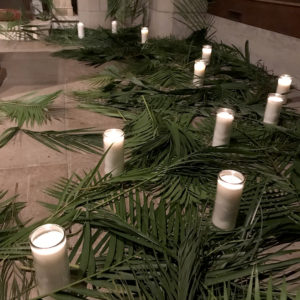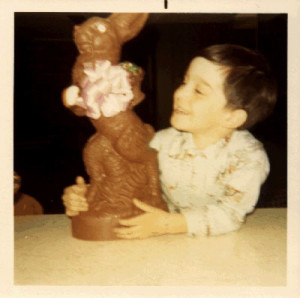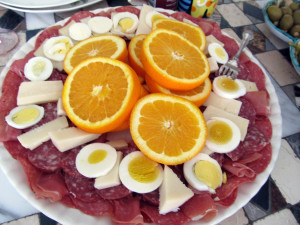I’ve been off from work this past week, and it was a wise move, taking off for Holy Week. The days were spent on projects and in preparation. I got to spend time with Seth and with the cat as I finished binding a book that someone had ordered and got to work in earnest once more on the book proposal for the Convivio Book of Days. I started fresh, fresh like spring, and I feel better about the proposal I’ve begun this week, much better than the one I began last fall. My friend Cricket gave me a bag of coffee as inspiration for my writing, and all that’s left is enough for one cup: the cup of coffee I will have when I send her the finished proposal.
We also got to help my mom and sister with Easter baking and we got to go on our annual Holy Thursday night pilgrimage of three churches. It was Seth and me on that pilgrimage and we were out late into the moonlit night. So beautiful. And this year I got to do something I had never done before: I went to church for Good Friday. And that was fine, church was. But the sermon made me uncomfortable and I felt a bit disconnected, until it was all over, when we all left the old church in silence, as we are to do on Good Friday. But as we left, I could hear the sounds of the Creole choir, also from our church. The Creole congregation were in the midst of the Stations of the Cross, outdoors on the sidewalk in front of the older church building, the one from the late 1800s. Their music drew me in and I gathered round the old church with them, leaning up against a live oak tree. They were at the final station. There was wailing and sorrow and there was singing I had never heard before but which sounded so familiar. They made their way then to the main church, the larger, newer one, the one built in 1913. They entered, singing, and I went on my way, content, happier for having run into this extension of myself.
Saturday night, I’ll be back, for the Easter Vigil. It is the hours-long Mass that brings in Eastertide. It can begin only after darkness has fallen, for it is then the third day, which used to confuse me a lot until I realized that different cultures have different ways of reckoning time. No one way is right, for time is such a fluid thing and yet an invention of our making. It will be the beginning of Easter and the second night of Passover, too. We will be there, sitting, standing, kneeling, singing, praying, in a service that will begin in darkness and end in light––a central theme to the Easter Vigil. A fire is kindled and the one light is the source that illuminates all the candles in the church: the candles on the altar, the candles we hold cupped in our hands. We are reminded that light overcomes darkness. We are invited to be that light.


